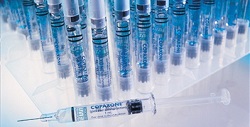 |
Teva ($TEVA) has had more success switching patients over to a new, long-lasting formulation of multiple sclerosis drug Copaxone than many analysts expected, achieving the fastest market adoption of any MS therapy in the United States. That's no accident, John Hassler, VP of marketing for Teva's central nervous system division, told FiercePharmaMarketing. It's the result of more than 18 years of building brand loyalty--a job for which the company was recognized last week.
On Thursday, Pharmaceutical Executive Magazine named the therapy its "Brand of the Year" for 2014. Hassler, who's been managing the med since prior to its 1997 launch, says Teva has been able to glean patient insights and focus brand-building on the ways Copaxone meets those needs.
"We knew in Copaxone we had a product that had demonstrated efficacy and had a strong safety profile that was appealing to patients and physicians," Hassler said, "but we also knew there were other needs patients had to get the most out of their drug therapy and optimize those therapeutic benefits."
So in 1996, Hassler and his team put together a suite of services they dubbed "Shared Solutions," and Teva's Copaxone marketing model was born. The Shared Solutions call center--which patients can call 24/7 to work with MS nurses, pharmacists, benefits investigators and others--became one of the company's biggest initiatives. The center handles nearly 1 million calls a year from Copaxone patients and from MS patients interested in learning more about the disease or drug therapy.
 |
| Teva CNS VP of Marketing John Hassler |
"That really has been one of the core efforts that has helped build loyalty to the brand over time," Hassler said.
And when digital marketing tools hit the scene, Teva added a few of those to its Copaxone efforts, too. Apps for computers or mobile devices provide reminders and allow patients to track whether they've taken their injections; patients can also sign up to receive reminders to help them use the product as it's prescribed, Hassler said.
All of that has been put to the test lately, with generic competition potentially on its way later this month. Teva's attempts to stave off copycats have so far fallen flat. A U.S. judge last year invalidated a key patent on the drug, chopping 18 months off Teva's exclusive hold on the market. Since then, the company has poured its efforts into converting patients to the new 40-mg dose. Each switch locks in future revenues for the Copaxone franchise, which generates more than half the Israeli company's profits.
Even so, the new Copaxone formulation won't replace the earnings power of the original once generics hit. But if Teva continues to track toward its goal of switching 30% to 50% of patients, the long-lasting version could give the generics giant a much-needed boost. Thanks to the organization's brand-centric focus, Hassler is confident it will.
"The ability to cross-functionally collaborate against a goal and to have those goals set against clear patient need, I think, has helped us achieve the results we've been able to achieve to date," he said.
- read the release
- get more from Pharm Exec
Special Reports: Top 10 Drug Patent Losses of 2014 - Copaxone | Top 10 Generics Makers by 2012 Revenue - Teva
Editor's note: This article has been updated to note that Copaxone launched in 1997.